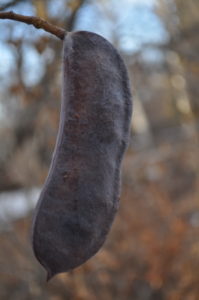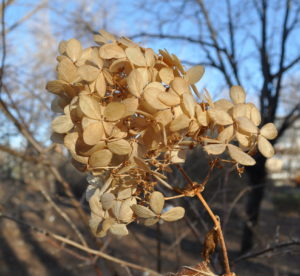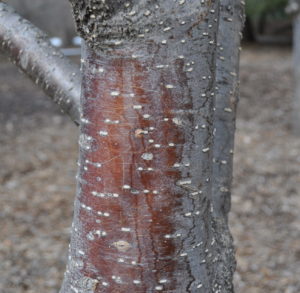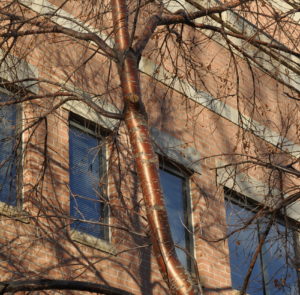Often when people think of trees in winter naturally the first image that comes to mind is that of evergreen conifers such as spruce, pine or fir. However, there are many other deciduous trees that feature great winter interest. Here is a list of eight trees that add a lot of winter interest to the landscape.

 Kentucky Coffeetree (Gymnocladus dioicus)
Kentucky Coffeetree (Gymnocladus dioicus)
This tree has a sculpted look and a very rugged form with striking fruits (large, brown, polished seed pods) on the female trees. All these features make this tree a real standout in the winter.
 American Hornbeam or Musclewood (Carpinus caroliniana)
American Hornbeam or Musclewood (Carpinus caroliniana)
This plant has fluted bark and the ability to thrive in a shady location, making it a great small tree choice. It produces fruit that looks like little pendant pagodas that persist on the tree through the winter.
 Redbud (Cercis canadensis)
Redbud (Cercis canadensis)
This smaller tree as it matures has flaky reddish bark and seed pods that cling all winter. Also, it appears no two trees are alike and some are groomed into single stems and others into multiple stems.
 Panicle Hydrangea (Hydrangea paniculata)
Panicle Hydrangea (Hydrangea paniculata)
This larger shrub or small tree is brilliant in the winter with amazing flower heads covering the plant. The plant is very showy with blooms in late summer and great for pollinators. Limelight is not a sterile variety and has many fertile flowers despite its cloak of showier sterile flowers. This clone has done well in our trials over the years.
 Paper or Canoe Birch (Betula papyrifera)
Paper or Canoe Birch (Betula papyrifera)
This superb, white-barked birch offers better resistance to borer than European birch in our trials over the years. The chalky white, exfoliating bark is outstanding in the winter landscape. This species is also excellent when used in groupings.
 Japanese Tree Lilac (Syringa reticulata)
Japanese Tree Lilac (Syringa reticulata)
This lilac is one of the most adaptable small trees or large shrubs for difficult sites. The bark is a nice winter feature, which is a lustrous brown with horizontal lenticels reminiscent of cherry bark. The white flowers in June are showy white panicles, which also add a great ornamental feature.
 Seven-Son Flower (Heptacodium miconiodes)
Seven-Son Flower (Heptacodium miconiodes)
This multi-stemmed and upright, spreading, small tree or large shrub has exfoliating bark that exposes a light-brown underbark. Another great feature of this plant is in the fall (September to October) when calyxes (sepals) from the white flowers turn red and last for a fairly long time.
 Amur Chokecherry (Prunus maackii)
Amur Chokecherry (Prunus maackii)
On a sunny winter day, the Amur Chokecherry is easily identified due to the glossy, amber to reddish brown to cinnamon-brown bark that provides spectacular color in the winter. Even the bark on young trees often exfoliates in a shaggy manner but loses this with age. The bark is definitely the most outstanding feature of this plant.










